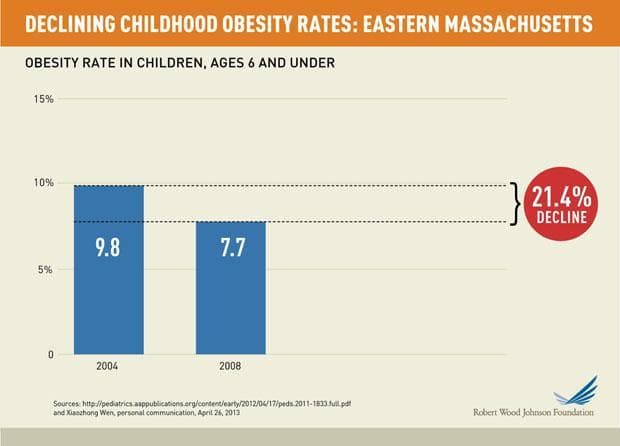Advertisement
In Greater Boston, Study Points To A Sharp — And Somewhat Mysterious — Drop In Childhood Obesity
Childhood obesity has been a source of deep concern for at least a generation.
But after years of widening bike lanes and forcing jicama on elementary school kids, public health officials seem to be making progress. The national childhood obesity rate has leveled off in recent years. And in some parts of the country, research suggests, a decline is underway.
The Robert Wood Johnson Foundation has rounded up the regional studies and found waistlines shrinking from Vance County, N.C., to Anchorage, Alaska.
But the most dramatic — and, perhaps, least scrutable — results are in eastern Massachusetts.
Researchers out of Harvard University's Obesity Prevention Program and the Centers for Disease Control and Prevention found a 21.4 percent drop in obesity rates in the region between 2004 and 2008 for children ages 6 and under.

It is the age of the kids that makes the result difficult to explain. Many of the most ballyhooed public health interventions — better walking routes to school, no more sugary drinks in the cafeteria — don't apply to infants and toddlers, after all.
There are some theories. Factors like reduced maternal smoking during pregnancy and increased breastfeeding might account for the steep drop here and similar, though far less dramatic, results nationwide.
Matthew Gillman, a professor of population medicine at Harvard Medical School and co-author of the study, adds that the media drumbeat on childhood obesity might have reached some sort of tipping point in the mid-2000s — shifting the behavior of parents of young children here and beyond.
Demography could explain the particularly strong results in eastern Massachusetts. Gillman and his colleagues studied 36,287 children who visited Harvard Vanguard Medical Associates between 1980 and 2008. That population — like the population of the region as a whole — skews more affluent than the national average. And greater wealth correlates with slimmer waistlines.
Indeed, within the confines of the study, children insured by Medicaid — a proxy for low family income — saw smaller declines in obesity.
But Gillman suggests that another, little-considered factor may have played a role in the drop in childhood obesity between 2004 and 2008.
Birth weight, which predicts weight throughout childhood, is on the decline nationwide.
No one knows what is behind that decline. Researchers have ruled out some of the most obvious explanations: maternal health issues like hypertension, for instance, or shifts in prenatal care. But it's happening.
And while low birth weight is a health concern, Gillman said, there may be an upside to the trend. "In today's world, where there's so much obesity," he said, "it's actually the big baby that may pose more problems than the small baby."
Intervening With Older Kids
If some combination of media saturation, relative affluence and low birth weight helps to explain the sharp decline in obesity among young children in greater Boston, there's also some encouraging news among older kids in the region.
The state has been measuring body mass index for children in Massachusetts school districts for three years now. Officials say it's too early to conduct any sort of trend analysis. But there is anecdotal evidence that public health interventions are having some effect.
Mass in Motion, a state program that aims to curb childhood obesity, has seen significant decreases in several low-income communities.
Among them: Fitchburg, which saw the childhood obesity rate drop from 46.2 percent in 2009 to 40.9 percent two years later — an actual decrease of 5.3 percent and a relative decrease of nearly 12 percent.
Fitchburg kids sing songs about fruits and vegetables in preschool, as WBUR reported earlier this year. Children plant community gardens. And teenagers, hired by the city, engage in peer education.
The progress there, and in other cities and towns across Massachusetts, owes something to a pioneering program in Somerville.
Shape Up Somerville launched in 2002. And five years later, it was the subject of the first-ever study showing that community interventions can have an impact on childhood obesity.
Another study, published last month, confirmed the program's promise.
The effort is broad in scope. Public health specialists have worked with restaurants to build healthier menus. And the city closes streets to automobiles, and opens them to pedestrians and bicyclists, through its SomerStreets program.
But Christina Economos, an associate professor of nutrition at Tufts University who helped launch the program, said the key to checking obesity in low-income communities — the key to overcoming "the assault of marketing, the lack of food access, the cheap processed convenience food in bodegas" — is working in the schools.
"What you get there is an opportunity to reach all children," said Economos, who served as lead author on both of the academic studies of Shape Up Somerville.
With most of the kids getting free or reduced-price breakfast and lunch, she said, there's a chance to have a significant impact on diet.
The trouble, she said, is that summer vacation pulls children out of the "protective" orbit of the school system. That means poor nutrition and more screen time.
Hence, her plea for a region trying to stay out front in the fight against childhood obesity: more summer programming.
This program aired on July 17, 2013. The audio for this program is not available.